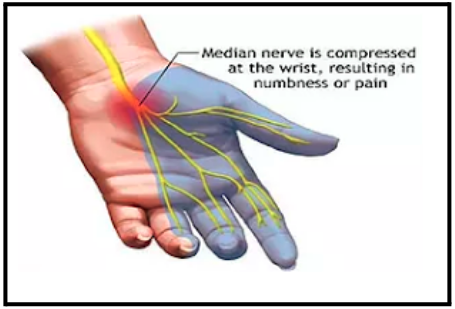Carpal Tunnel Syndrome
Carpal tunnel syndrome is a common disorder of the hand, caused by pressure on the median nerve where it runs through the carpal tunnel of the wrist.
The carpal tunnel is a narrow passageway in the wrist. It is formed by the carpal bones of the wrist at the bottom and the transverse carpal ligament on the top. As well as the median nerve many tendons run through the carpal tunnel and if any swelling occurs the median nerve can be compressed.
The most common symptom is numbness or tingling in the thumb and first 3 fingers and palm (the little finger is not supplied by the median nerve). Usually starting at night, as the wrist flexes during sleep and the result is compression of the median nerve. Numbness and tingling can occur at other times, particularly when the wrist is flexed, commonly when driving or using the phone.

Carpal tunnel syndrome is a common disorder of the hand, caused by pressure on the median nerve where it runs through the carpal tunnel of the wrist.
The carpal tunnel is a narrow passageway in the wrist. It is formed by the carpal bones of the wrist at the bottom and the transverse carpal ligament on the top. As well as the median nerve many tendons run through the carpal tunnel and if any swelling occurs the median nerve can be compressed.
The most common symptom is numbness or tingling in the thumb and first 3 fingers and palm (the little finger is not supplied by the median nerve). Usually starting at night, as the wrist flexes during sleep and the result is compression of the median nerve. Numbness and tingling can occur at other times, particularly when the wrist is flexed, commonly when driving or using the phone.
More advanced carpal tunnel syndrome will cause damage to the nerve supplying the muscles of the thumb, causing weakness.
Pain is not usually a major symptom of carpal tunnel syndrome, sometimes there is a shock-like sensation from the wrist. More advances carpal tunnel syndrome may be painful.
CAUSES OF CARPAL TUNNEL SYNDROME
Conditions associated with carpal tunnel syndrome are;
- Osteoarthritis or inflammatory arthritis
- Injury to the wrist, including fractures and soft tissue injury
- Pregnancy is a common cause due to fluid retention. Carpal tunnel syndrome associated with pregnancy usually resolves after birth.
- Overuse. Occupations with repetitive movement increase risk.
Often there is no known cause, sometimes there may be more than one contributing factor.
TREATMENT OF CARPAL TUNNEL SYNDROME
Mild carpal tunnel syndrome can be treated with rest. Splints can be worn at night to prevent flexion of the wrists and this may improve your sleep. Splints have not been shown to prevent the progression of carpal tunnel syndrome.
When testing shows moderate or severe carpal tunnel syndrome surgery is often recommended, this is something you can discuss with your GP.
Some doctors use cortisone injections which may be helpful in reducing inflammation in the carpal tunnel.